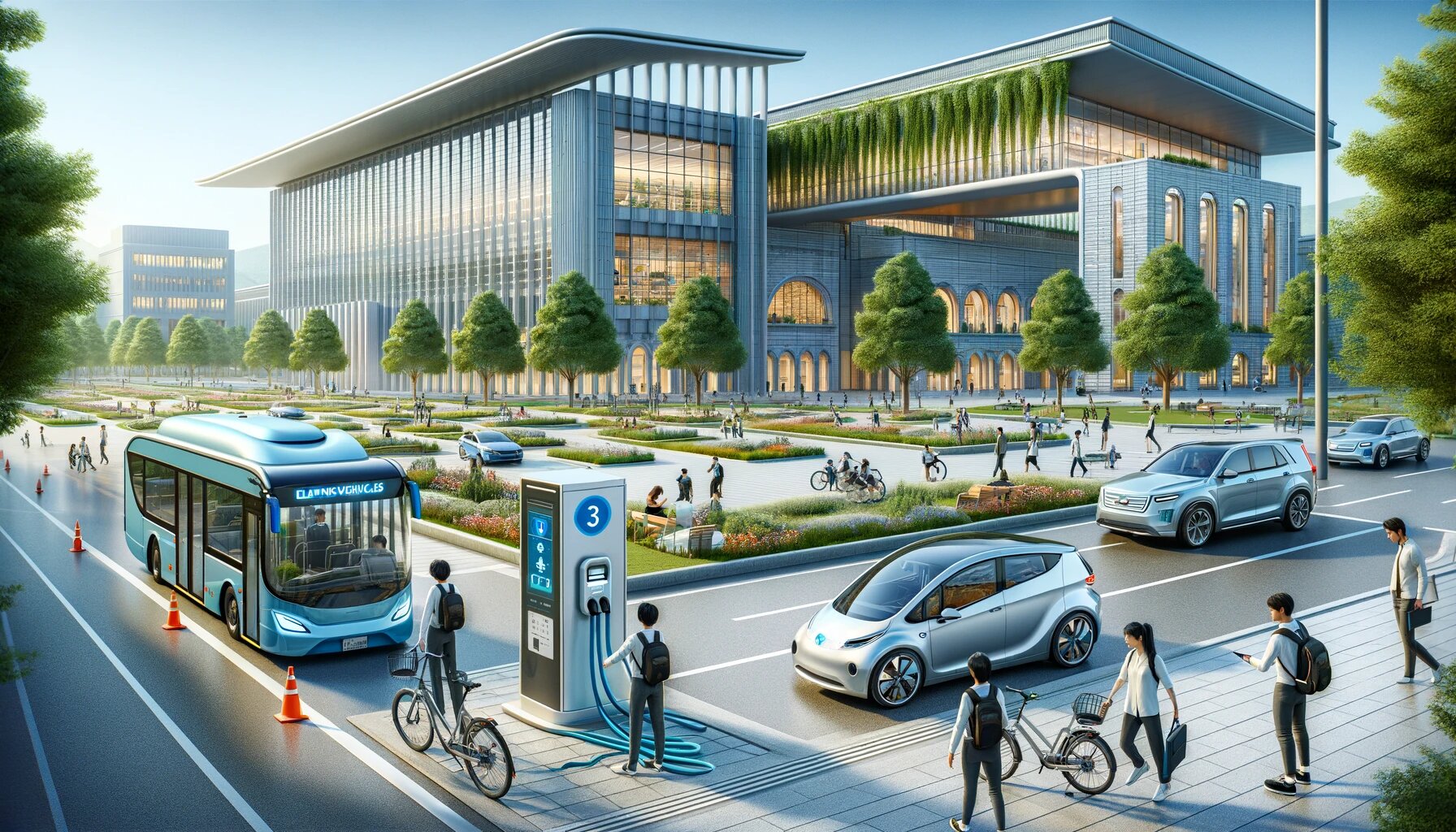Introduction
The transportation landscape is undergoing a significant transformation with the advent of electric vehicles (EVs). From reducing greenhouse gas emissions to lowering operational costs, electric vehicles have become a game-changer in the automotive industry. Universities, often at the forefront of sustainability initiatives, are also recognizing the potential of EVs to revolutionize campus transportation. In this article, we will explore how electric vehicles are becoming the future of university transportation, with a focus on the environmental benefits, cost-efficiency, and the integration of EVs into campus fleets.
The Environmental Imperative
Reducing Carbon Footprint
Universities are increasingly committed to reducing their carbon footprint and embracing sustainability. One of the most significant contributions to this effort comes from transitioning to electric vehicles. EVs produce zero tailpipe emissions, substantially reducing greenhouse gases, air pollution, and noise pollution. Universities can take a significant step toward achieving their environmental goals by replacing traditional gasoline or diesel vehicles with electric ones.
Promoting Clean Energy
To enhance the environmental impact further, universities can invest in renewable energy sources, such as solar panels and wind turbines, to charge their electric vehicle fleets. This synergy between clean energy production and clean transportation can create a closed-loop system that greatly reduces the overall carbon footprint of a university campus.
Setting an Example
Universities serve as role models for their students and communities. By adopting electric vehicles and sustainable practices in their transportation systems, they set a powerful example for students and inspire them to embrace eco-friendly choices in their own lives. This educational aspect of EV adoption contributes to a more sustainable future beyond the campus boundaries.
The Financial Advantage
Lower Operating Costs
Electric vehicles have a clear financial advantage over their gasoline or diesel counterparts. The cost per mile for running an electric vehicle is significantly lower due to cheaper electricity compared to gasoline and the greater efficiency of electric motors. Universities can save on fuel and maintenance costs, allowing them to allocate resources to other critical areas.
Access to Incentives
Numerous government incentives and grants are available to encourage the adoption of electric vehicles. These incentives can significantly offset the initial purchase price of EVs and charging infrastructure, making it more financially attractive for universities to invest in electric transportation. Additionally, some jurisdictions offer tax incentives and rebates that further enhance the cost-efficiency of electric vehicles.
Long-term Investment
Electric vehicles have a longer lifespan and require less maintenance than traditional vehicles. With fewer moving parts and simplified maintenance needs, universities can expect to use their electric vehicles for many years, resulting in long-term cost savings and a higher return on investment.
Sustainability Initiatives and Electric Vehicles
In the pursuit of environmental stewardship, universities are increasingly aligning their sustainability initiatives with the adoption of electric vehicles (EVs). This strategic integration not only reduces the carbon footprint of campuses but also reinforces the commitment to sustainable practices.
Incorporating EVs into Sustainability Plans: Universities are revising their sustainability plans to incorporate the deployment of electric vehicles. These updated blueprints often outline targets for reducing greenhouse gas emissions and emphasize the role of EVs in achieving these goals. The inclusion of EVs in sustainability plans signifies a holistic approach to environmental responsibility.
Public Perception and Support: Sustainability initiatives involving EVs often enjoy broad support from students, faculty, and the community. EVs are seen as tangible evidence of a university’s commitment to eco-consciousness, attracting positive attention and fostering a culture of sustainability. Moreover, such initiatives can serve as valuable PR tools, showcasing the institution’s dedication to a cleaner future.
Partnerships with Environmental Organizations: Collaborating with environmental organizations can amplify the impact of university sustainability initiatives. By joining forces with NGOs and green advocacy groups, universities can access additional resources, knowledge, and expertise to advance their EV programs. These partnerships create a synergy that benefits both the university and the broader sustainability movement.
Incorporating electric vehicles into sustainability initiatives not only fulfills environmental goals but also enriches the overall sustainability narrative of universities, inspiring collective action and creating a more sustainable campus and community.
Integration into Campus Fleets
Expanding Charging Infrastructure
To successfully integrate electric vehicles into university transportation, institutions need to invest in charging infrastructure across campus. This infrastructure includes Level 1 and Level 2 chargers for convenient and efficient vehicle charging. By strategically placing charging stations in high-traffic areas, universities can ensure that electric vehicles remain a practical choice for both students and staff.
Vehicle Diversity
Universities often require a diverse range of vehicles, from passenger cars to buses and maintenance vehicles. Fortunately, the EV market offers an expanding selection of electric options, including electric cars, vans, and even electric buses. This diversity allows universities to find electric vehicles that meet their specific needs while reducing emissions across the board.
Fleet Management Software
To optimize their electric vehicle fleets, universities can implement fleet management software that provides real-time data on vehicle usage, charging status, and maintenance needs. This technology helps streamline operations, reduce downtime, and ensure that electric vehicles remain an integral and efficient part of the campus transportation system.
Overcoming Challenges
Initial Investment
While the long-term cost savings of electric vehicles are undeniable, universities may face initial financial barriers to adoption. The purchase of electric vehicles and the installation of charging infrastructure can be a significant upfront expense. To overcome this challenge, universities can seek grants, incentives, and partnerships with private companies to offset the initial costs.
Range Anxiety
One common concern with electric vehicles is range anxiety—the fear of running out of battery power before reaching a destination. Universities can address this issue by strategically placing charging stations throughout their campuses and providing easy access to charging facilities. Additionally, the growing availability of fast-charging stations in urban areas can alleviate range anxiety for longer trips beyond campus boundaries.
Education and Training
Effective adoption of electric vehicles in university fleets requires education and training for drivers, maintenance staff, and fleet managers. Training programs can ensure that users understand how to operate, charge, and maintain electric vehicles, maximizing their efficiency and longevity.
Case Studies: Universities Leading the Charge
Several universities have taken pioneering steps in adopting electric vehicles (EVs) as part of their transportation fleets, setting inspiring examples for others to follow.
Notable University EV Programs: Stanford University in California has emerged as a trailblazer in integrating EVs into its transportation ecosystem. Stanford has drastically reduced its carbon emissions with a comprehensive charging infrastructure and a diverse range of electric vehicles. Similarly, the University of Michigan has implemented an ambitious plan to electrify its campus fleet, aiming to replace all internal combustion vehicles with electric alternatives within the next decade.
Success Stories and Lessons Learned: Oregon State University’s experience offers valuable insights. By transitioning their shuttle buses to electric ones, they achieved a 65% reduction in greenhouse gas emissions while significantly lowering maintenance costs. Likewise, the University of California, Irvine, successfully implemented an electric bike-sharing program, reducing on-campus traffic congestion and emissions.
Student and Staff Feedback: In these case studies, the feedback from students and staff has been overwhelmingly positive. Users appreciate the reduced noise pollution, smoother rides, and the satisfaction of contributing to a greener environment. These testimonials underscore the value of EV adoption beyond mere cost savings.
These case studies highlight the tangible benefits of electric vehicle integration, motivating other universities to follow suit. They serve as real-world examples of how EVs can be effectively incorporated into campus transportation, leading the way toward a more sustainable and eco-friendly future.
Conclusion
Electric vehicles are rapidly becoming the future of university transportation, driven by their environmental benefits, cost-efficiency, and the growing availability of charging infrastructure. As universities seek to reduce their carbon footprint and set an example of sustainability, electric vehicles offer a practical and impactful solution. By investing in electric vehicles, universities contribute to a cleaner environment and make sound financial decisions that can lead to long-term savings and operational efficiency. As the EV market continues to evolve and improve, universities will play a vital role in shaping the future of sustainable transportation on campus and beyond.

